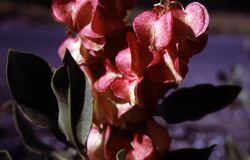Biology:Rumex venosus
| Rumex venosus | |
|---|---|

| |
| Scientific classification | |
| Kingdom: | Plantae |
| Clade: | Tracheophytes |
| Clade: | Angiosperms |
| Clade: | Eudicots |
| Order: | Caryophyllales |
| Family: | Polygonaceae |
| Genus: | Rumex |
| Species: | R. venosus
|
| Binomial name | |
| Rumex venosus | |
Rumex venosus is a species of flowering plant in the knotweed family known by the common names veiny dock,[1] winged dock, sand dock,[2] and wild-begonia (though it is not related to the genus Begonia). While not of any particular agricultural use, its cousins rhubarb and buckwheat are. It is native to central and western North America, from southern parts of the Canadian prairies, through to Mexico.
It can be found in many types of habitat, including sagebrush, dunes, and other sandy areas.[2] It is commonly found in heavily grazed pastures as livestock tend to avoid it, allowing veiny dock to spread uninhibited. It is a common food plant of the ruddy copper butterfly.[3]
Description
It is a perennial herb producing decumbent, spreading, or upright stem 4 to 20 centimetres (1 1⁄2 to 8 in) tall,[4] usually with a few branches. It grows from a creeping rhizome.[2] The light green leaves are veiny (lending the species its name),[4] lance-shaped to oval with smooth or wrinkled edges, and grow 2–15 cm (3⁄4–6 in) long[2] and 1–5 cm (1⁄2–2 in) wide.[4] Each leaf has a papery, sheath-like stipule above it.[2] The inflorescence grows as either an axillary or terminal panicle and is densely flowered. The flowers themselves are not showy, being green and inconspicuous. They have 6 reddish[2] sepals, 6 stamen, and 1 pistil. The bright, pink colour of the flowers comes from the inner sepals of each flower when the fruit matures.[4] The sepals enlarge to about 3 mm (1⁄8 in) long[2] and 1.5 cm across, turning quite veiny, and surround the achene. The plant flowers from mid-spring to mid-summer.[4]
Uses
Like all docks, Rumex venosus is considered edible,[citation needed] but the young leaves tend to be too sour to be palatable. Since the leaves and shoots remain tender for most of the growing season, docks make good cooked vegetables, similar to beet shoots, but will likely require multiple boiling to remove some of the bitter taste. The achenes can be boiled into a mush or ground into a flour, but the process of removing the seeds from the chaff is considered too time consuming to be worth the effort. Docks contain high levels of vitamin C and beta-carotene, with Rumex crispus having the highest levels, greater than that of oranges and carrots, respectively.[citation needed]
The leaves have been used to relieve the burning of stinging nettle, and can be dried and used as a powder to help speed the healing of wounds. Docks contain anthraquinones, which have laxative and antibacterial properties, as well as stopping the growth of some parasites and fungi.[citation needed] The roots were mashed for use as a poultice.[4] The roots can also be boiled to make red, yellow, or black dye.[4] Native Americans made an orange dye.
Precautions
Rumex venosus contains toxic oxalates which can cause vomiting, cramps, or diarrhea. While a large quantity would have to be consumed in order to experience these toxic effects, it is recommended that people with kidney problems, the elderly, or small children refrain from using docks. Calcium is known to neutralize the oxalates, making it advisable to serve the vegetable with a cream sauce.
References
- ↑ "Rumex venosus". Natural Resources Conservation Service PLANTS Database. USDA. https://plants.usda.gov/core/profile?symbol=RUVE2. Retrieved 26 October 2015.
- ↑ Jump up to: 2.0 2.1 2.2 2.3 2.4 2.5 2.6 Taylor, Ronald J. (1994) (in en). Sagebrush Country: A Wildflower Sanctuary (rev. ed.). Missoula, MT: Mountain Press Pub. Co. pp. 32. ISBN 0-87842-280-3. OCLC 25708726. https://www.worldcat.org/oclc/25708726.
- ↑ Warren, Andrew; Harrera, Alfonso. "Butterflies of Oregon Their Taxonomy, Distribution, and Biology". Lepidoptera of North America 6.
- ↑ Jump up to: 4.0 4.1 4.2 4.3 4.4 4.5 4.6 Fagan, Damian (2019). Wildflowers of Oregon: A Field Guide to Over 400 Wildflowers, Trees, and Shrubs of the Coast, Cascades, and High Desert. Guilford, CT: FalconGuides. pp. 218. ISBN 1-4930-3633-5. OCLC 1073035766. https://www.worldcat.org/oclc/1073035766.
External links
- Jepson Manual Treatment
- Washington Burke Museum
- Calflora: Information on California plants for education, research and conservation, with data contributed by public and private institutions and individuals, including the Consortium of California Herbaria, Berkeley, California: The Calflora Database, https://www.calflora.org/cgi-bin/species_query.cgi?where-taxon=Taxon name (parameter 1) is required.
- "Rumex venosus". http://www.pfaf.org/user/Plant.aspx?LatinName=Rumex+venosus.
Wikidata ☰ Q3008482 entry
 |

